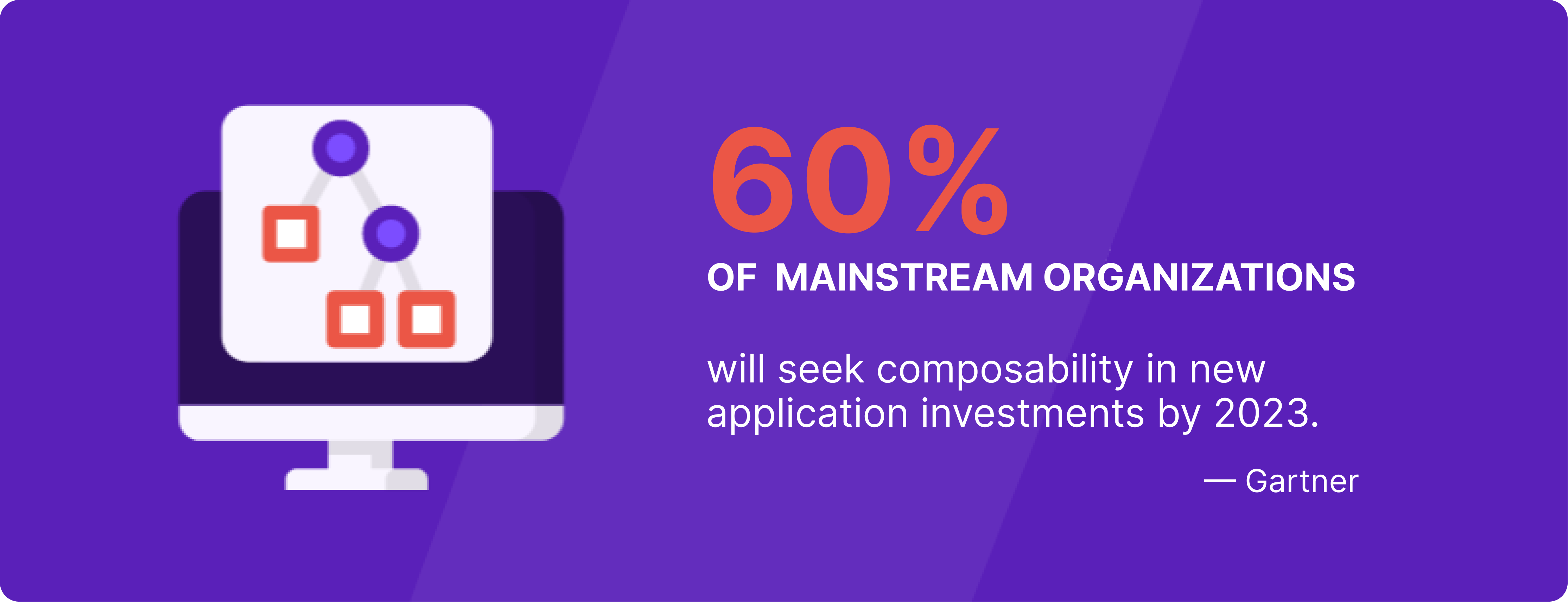Composable DXP: A cost-efficient approach for businesses

Share

Discover how a composable DXP improves cost efficiency and flexibility. Streamline your digital strategy with modular solutions tailored to your business needs. Embrace innovation and ease of use without costly infrastructure.
Highlights
You’ll learn how composable DXP supports cost-efficiency:
- Modular design: Invest in and integrate only modules that serve your business goals
- SaaS platform: Eliminates the need for extensive infrastructure—just plug-and-play
- Ease of use: Reduces dependency on IT for changes and updates
- Scalable solutions: Update or replace modules without a full system overhaul
Discover cost-saving benefits with a composable DXP—reduce operational costs while maintaining service delivery quality.
If you are struggling with rising operational costs, it makes business sense to explore cost-cutting measures. However, that is easier said than done. When businesses cut costs, they risk diluting the quality of their digital experience. Fortunately, a composable DXP offers the tools to create quality experiences without costly technology infrastructure.
Since it is a SaaS platform, you do not need to set up servers or build extensive background infrastructure. Each module is independent, so you can scale, replace, or update it without impacting the entire system. You also do not worry about costly system shutdowns or upgrades, but this was not always the case.
The evolution of DXPs
DXPs have gone from all-in-one platforms to flexible platforms that you can now build from the ground up. It used to be one large, integrated platform that locked you into a single vendor solution. These days, you can select digital solutions from multiple vendors.
- Traditional DXPs: While traditional DXPs were powerful, they were often hard to customize. DXP vendors try to cover all bases, so you end up with a bloated platform with features that do not serve your business. They also required extensive development work to update, making them unsuitable for rapid innovation.
- Composable DXPs: Composable DXPs offer more freedom and flexibility as you are not tied to one vendor. You ‘compose’ it because you only add digital services that serve your business goals. With microservices, APIs, cloud, and headless CMS, you can innovate and adapt to market shifts quickly.
Aside from the need to adapt quickly to market and tech shifts, more user-friendly platforms were also needed.
In a typical traditional DXP, marketers would need to send changes to the IT department, which would require extensive technical work. With composable DXPs, business users can make all the changes they want while developers focus on building a suitable front-end framework.

Composable DXP and its architecture
A composable digital experience platform (DXP) is a modular platform that integrates various best-of-breed solutions to create a unified digital experience. Think of it like an orchestra, where each separate instrument works together with others to create good music. Here are the basic components of a composable DXP.
- Headless CMS: It manages content by separating content storage from its presentation. So marketers can edit and manage content on the back end for flexible content delivery across multiple channels.
- Microservice: Microservices break applications into smaller, independent services that perform specific functions. You can deploy and scale each one on its own.
- API-first approach: This prioritizes APIs when setting up the platform. It ensures modules can interact, and you can integrate various services and third-party apps.
Start your free trial with Contentstack today. Transform your brand's digital presence with Contentstack's open MACH architecture and industry-leading technology. Witness a significant reduction in publishing and development time, and elevate your content management. Start your free trial now.
Ease of use in composable DXP
As stated earlier, a composable DXP is a simplified system for business users. Integrating a headless CMS allows marketers to manage, edit, and update content, freeing up developers to focus on creating user-focused front-end solutions.
Composable DXPs are also SaaS platforms, so they are easy to set up. They reduce the time to end-user benefit and can scale on demand. The vendor manages updates for the most part.
Maximizing ROI with a composable DXP
Composable DXPs offer cost efficiency through their modular solutions. You only invest in modules relevant to your business needs, enabling you to save costs. It also offers tools that allow you to tailor digital solutions.
According to this recent McKinsey report, 71% of consumers expect personalized solutions. This improves customer engagement and high conversions. Fast-growing brands have also been shown to drive 40% more of their revenue from personalization. In that sense, a composable DXP enables you to maximize your ROI.
Case studies
MongoDB
For MongoDB, managing five core websites and multiple CMSes was costly and time-consuming. On top of that, it was hard to align IT and business. Also, none of the systems were suited for their future focus on agility.
They needed a solution to unify content management and save costs. Contentstack offered the platform that enabled them to harmonize content and publish faster. With the composable DXP and headless CMS, they were able to migrate over 250 pages and offer supported seven languages.
Hear from the Engineering Lead, Subi Babu. "Coming from an in-house CMS, our background for several years was focused on developing CMS features. Now, we can use the marketplace and get plug-and-play integrations, which is exciting."
Read how MongoDB modernized via a composable DXP.
Equipment auction leader
With higher demands, an Equipment auction leader needed to save costs and empower its marketers. They wanted to reduce IT dependence, prioritize an API-first approach, and tailor content to the needs of various regions.
Opting for Contentstack's composable DXP allowed them to address those needs. Contetnstack’s API-first approach allowed marketers to control the content side. While developers built reusable content blocks, marketers filled them with content, and editing became easier.
According to Director of Product at Equipment auction leader, "It's now extremely easy for the marketing team to go and change content, and that immediately flows to the website without needing any technical assistance."
Read more about how an Equipment auction leader freed up developers with a composable DXP.
Contentstack: Your partner in scaling digital experiences. Twice named a Leader in Forrester's composable DXP award, Contentstack offers an innovative approach to DXP. Experience our 100% microservices architecture and API coverage that allows instant scalability. Start your free trial today.
Implementing composable DXP for cost savings
Cost efficiency is a logical reason for businesses to consider a composable DXP. With easier setup and most of the infrastructure hosted in the cloud, businesses do not need to invest in costly infrastructure and servers. Here is a step-by-step guide to implementing composable DXP for cost savings:
- Assess current systems: Evaluate your tech stack to identify parts that can be replaced, upgraded, or integrated with a composable solution. Consider system compatibility and data management.
- Select the right solution: Choose DXP vendors and tech partners that align with your business goals and integration needs. Consider security, ease of use, and ROI. As a good practice, read customer success stories to see what past customers have said and if they align with your goals.
- Develop a transition plan: Outline a clear roadmap to guide your transition. Note action items, timelines, and milestones. Also, allocate resources and clarify the roles each team member will play. Ensure there is adequate stakeholder support.
- Avoid common pitfalls: Understand potential challenges such as integration complexities and data migration issues. That will enable you to create proper plans to manage them.
These steps will enable you to transition to a composable DXP and save costs.
Future-proofing your digital strategy
When analyzing long-term cost benefits, you want to be sure that your investments are flexible and scalable. By scalable, we mean that your tech stack can support business growth. For instance, you can deliver your services to more regions or multiple languages without prohibitive costs.
The modular nature of composable DXPs means that you can integrate a localization module for the above use case. The use of APIs also supports agility. So, you can adapt to new industry trends or develop new solutions as quickly as your customers need them.
FAQ section
What are the core benefits of a composable DXP?
Composable DXPs enable cost savings by eliminating the need to build underlying infrastructure. They are also easy to use and scalable and allow you to tailor digital experiences to your customers' needs.
How can businesses measure ROI from Composable DXP?
To measure ROI, assess improvements in customer engagement and conversions. Also, consider the cost savings and increased revenue after going composable.
Why is the API-first approach crucial for digital platforms?
An API-first approach enables seamless integration between different modules. It ensures that modules and PBCs can interact and share data without hassles. That enables you to create a cohesive digital experience.
What cost benefits can enterprises expect from Composable DXP?
It reduces operational and maintenance costs. It also allows for better resource allocation, as you only integrate what you need. A composable DXP also empowers your business users and reduces reliance on IT.
Learn more
A composable DXP offers ease of use and cost efficiency. It allows you to integrate only necessary modules. It is also scalable, providing the support and infrastructure that enables you to grow and serve more customers.
Contentstack offers the industry-leading composable DXP for cost-saving and revenue growth. It is easy to use, secure, and API-first. Consider switching to Contentstack to manage costs while delivering exceptional and tailored digital experiences. Talk to us today to start your composable journey.



